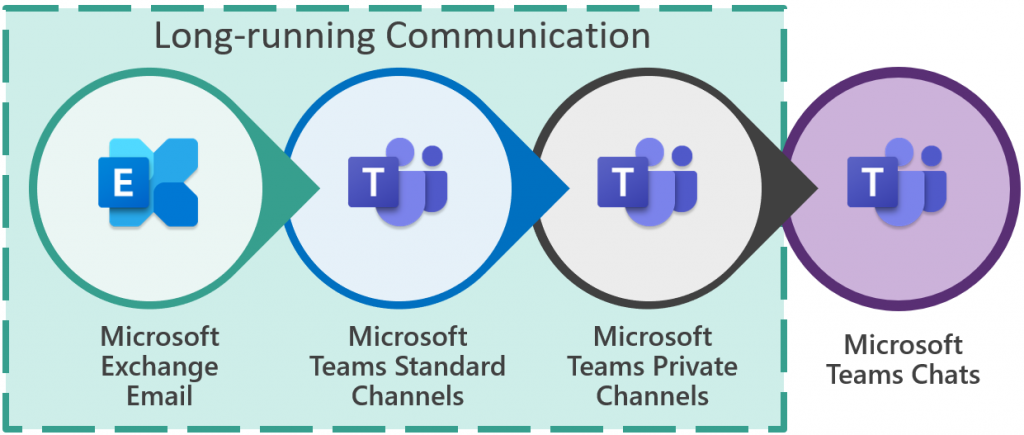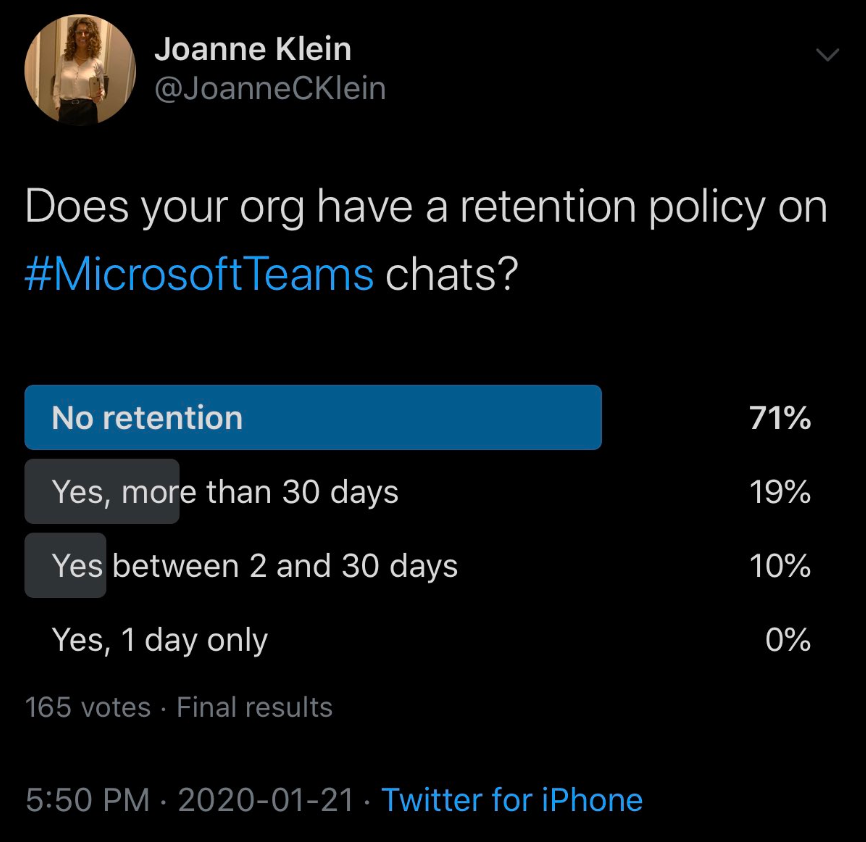Microsoft Teams/Email Retention and its Impact on User Adoption


Getting started with Microsoft Teams for the first time? Check out our webinar “From Take-Off to Landing: 6 Steps to a Successful Microsoft Teams Pilot.” Register here!
Strong retention can be difficult to carry out for any organization. In a modern workplace, having an overall Communication Retention Strategy from the start can be vital in implementing retention across digital communication channels.
While recently observing customers implementing Office 365 retention, I made a notable discovery: Retention consistency can have a significant impact on end-user adoption.

To explain, let’s consider the 4 main modes of digital communication and their typical use cases in a modern workplace today:
1. Exchange email: The oldest of the communication tools with the most end-user comfort across the board. Most organizations I work with either have no explicit retention in place to automatically delete emails, or their retention has been configured to ensure they’re retained for a very long time (or forever).
-
- Use case: Users often use their email inbox as a knowledge repository, particularly the “email-hoarders.” ?
2. Microsoft Teams standard channel posts: A chat-based communication channel available and visible to all members of a Microsoft Team. Organizations’ modern workers are starting to replace traditional email communication with Channel posts for its transparency, modern features (likes, gifs, etc.), and alignment with a modern, progressive, digital way of working.
-
- Use case: Often used for long-running communication, knowledge sharing, notifications, and business decisions for projects, departments, communities, etc.
3. Microsoft Teams private channel posts: Like the above, but communication is only available to members of the private channel and not the entire membership of the Microsoft Team. These are the relative newcomers and organizations are just starting to try them out.
-
- Use case: By its nature, communication within a private channel will likely revolve around confidential, private, or sensitive work within a Team. Rolling out now is the ability to have a retention policy on private channel posts, making this new form of communication a viable option for regulated organizations.
4. Microsoft Teams private and group chats: A chat-based platform to support 1:1 and Group chats amongst members of an organization, including guest users.
-
- Use case: Often used for social sharing, quick decisions, and miscellaneous tidbits of information. Although strategic business decisions are typically not made in a chat, lower-level ones certainly can be. In other words, there can be valuable business information stored in Teams chats.

If we consider the first three modes as typical “long-running” communication styles and the last one as a “short-to-medium-term” communication style, any retention your organization applies to them should align with this.
An organization should have an overall Communication Retention Strategy to effectively implement retention across all four modes of communication in a fit-for-purpose way and ensure staff is armed with the knowledge to know what kind of content should be stored in each one and how long it will be retained.
Communication Retention Strategy
Are you applying retention to long-running communication? If so, are you applying it consistently?
Whether your retention requirement is “no retention at all,” “retain content forever,” or “delete content after X days/months/years,” it needs to be applied consistently across the first three modes of long-running communication: email, Microsoft Teams standard channels, and Microsoft Teams private channels.
Why? Although email is very different from standard and private channel posts in Teams, these three communication modes will likely be perceived by information workers to have similar use cases, and they will therefore expect similar retention. If it’s not handled this way, you may erode the end user’s trust in whichever one has the shorter retention period.

With the increased adoption of Microsoft Teams and as information workers are increasingly moving their communication from traditional email to Teams channel posts and chats, this is a critical piece of your retention strategy to consider.
In other words:
- If you don’t have retention on email, don’t have it on Teams Channel Posts
- If you have a “retain forever” policy on email, have the same on Teams Channel Posts
- If you have a “delete after two years” policy on email, have the same on Teams Channel Posts
What About Microsoft Teams Chat? Is This Different? Yes.
In some/most organizations, Teams chat is often seen as a temporary communication mechanism not to be used for long-term business decisions.
Whether this is what transpires in our Team chats or not is hard to know, but most customers I work with see Teams chat as a potential liability in an organization if held onto for too long. For instance, legal teams may be concerned if eDiscovery has visibility into Teams chat history (e.g. a disparaging chat about a customer).For this reason, I often see shorter retention periods placed on Microsoft Teams chats.
Recently, after Microsoft announced the addition of a one-day retention policy for these chats, I posted a Twitter poll asking the community if their organization was currently using a retention policy on their Teams chats and, if so, for how long. Here are the results:

From this sample set of 165, none of the respondents were retaining for one day, but roughly 30% did have some level of retention. This is consistent with what I see with my customers as well.
Don’t Surprise Your Users!
If your organization has decided to apply a retention policy to chats, ensure staff are informed of the retention period so they’re not caught off-guard when their chats suddenly start going away! Remember, this includes both 1:1 and Group chats.
Does this affect end-user adoption? It certainly could. While working at a customer’s site recently, I had some Teams chats deleted due to a retention policy in their tenant configured to delete after 30 days. As a result, I lost some important chats (shared links, operational discussions, quick decisions, etc.).
My reaction was frustration; however, the policy was put in place for compliance reasons and these types of things are generally considered non-negotiable. What this has done, however, is changed my behavior in how I manage the chat content I want to keep longer than 30 days.
For example, instead of putting something in a chat, I might put it in a Teams post instead. Or maybe I copy the information I want to retain from a chat to another more permanent location once the chat is done. These are both good alternatives, but they require a concerted effort on the end-user’s part to make this decision and act on it.

5 Key Things to Remember
Before publishing retention policies across your organization’s communication channels, do these things:
- Ensure you have “where to communicate what” guidelines in your organization.
- Ensure you have consistent default retention periods across all long-running communication channels (emails, standard channels, private channels).
- Apply additional retention policies as required with different retention periods to detect and retain sensitive information found in communication channels.
- Decide if you will apply a retention policy to Teams chats.
- Ensure end-users are trained on your guidelines and what the retention periods are.
Closing Thoughts
If your organization has bought into the Teams ecosystem and believes Microsoft Teams is the future, spend time ensuring the retention configuration is well-thought-out, fit-for-purpose, and strategically applied across all four communication modes to drive sustainable adoption and appropriate use of Microsoft Teams and email. Don’t forget to include end-user training as an integral part of your program!


